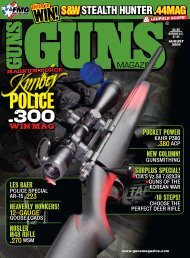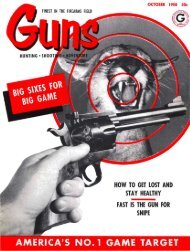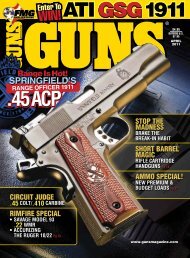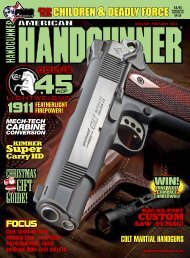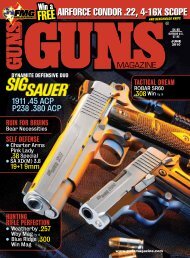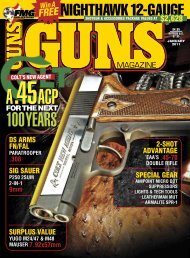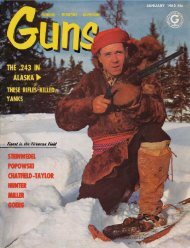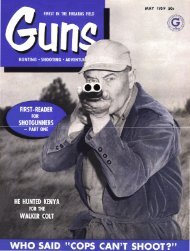GUNS Magazine December 1958 - Jeffersonian
GUNS Magazine December 1958 - Jeffersonian
GUNS Magazine December 1958 - Jeffersonian
You also want an ePaper? Increase the reach of your titles
YUMPU automatically turns print PDFs into web optimized ePapers that Google loves.
Conventional rifle oraetice is (too l outmoded bv Trainfirehas been revived beca use it is quick to get in and out of,adjustable to existing cover, fairly steady, and flexibleenough in elevation to see the target with minimum exposureof the firer. Prone is tau ght but not practiced much,because it is not likely to be used much . Men hesitate to liedown in water, snow, or blood y mud, or on ground withpossible chemical or atomi c contamination ; and even slightgrass cover prevents seeing anything from prone.At first the trainee shoots at aiming points 25 metersaway. At thi s short range, with the man-weapon combinationseparated from the extraneous variables of light,weather, and distance, he learns steady holding, aim ing,and the adjustment of sights. He learns accuracy as evidencedby tight shot groups. He then zeroes his rifle toengage gro und level man -sized field targets. From now onall his tr aining is against these "killable" targets.These are E silhouettes, cardboard cut-outs of a man -likefigur e in a crouching position, 19 inches wide and 40 incheshigh. They are moun ted on a dug-in target machine whichraises and lowers them from a central control tower; whenthe silhouette is hit by a bullet, it automatically goes down,is "killed." This gives the man instantaneous knowledgeof results which the psychologists call "feedback." He thenknows what to do next : fire another shot if he misses, or, ifhe kills, wait for the next target. In some of the shootingpractice he does thi s, being pr ovided with a few extrarounds to use according to his best judgment. This is whathe would do in combat. The automatic target not onlypr ovides feedback, but it allows very rapid run-off ofpractice, for there is no waiting to learn the score. It isalso very economical of manpower ; pushbutton operationof the targets completely eliminates th e former laboriouspit details.Scoring is hit or miss, on the theory th at a rifle bulletanywhere in a man 's bod y ' is enough. If the target goesdown, it's a hit ; if it doesn't go down, or the man fail s to.shoot before the whistle, it's a miss. The total hit s ar e thescore.Each shooter has a lane to watch in which targets ma yappear from 75 to 300 meters away. He takes them as the ycome, sometimes from the foxhol e, out in front of it invarious positions, or walking down ra nge and assumingposition of choice when the target app ears.Concurrently he receives daily training in something newand important to battle marksmanship: target detection. Inthis the trainees line up and watch an apparentl y emptyfield. Camoufla ged men are out there. Sometim es they aremotionless in plain sight, from 20 to 350 meters away. Atother tim es they make furtive movements, fire a rifle, orrun and go down . The tr ain ee has to spot them, recordthem on a piece of paper or point a simple aiming device atwhere he thinks they are. Looks easy ? It's not. Many anold game hunter would be completely fru strated. The remarkablething is that fair to (Continued on page 44)




